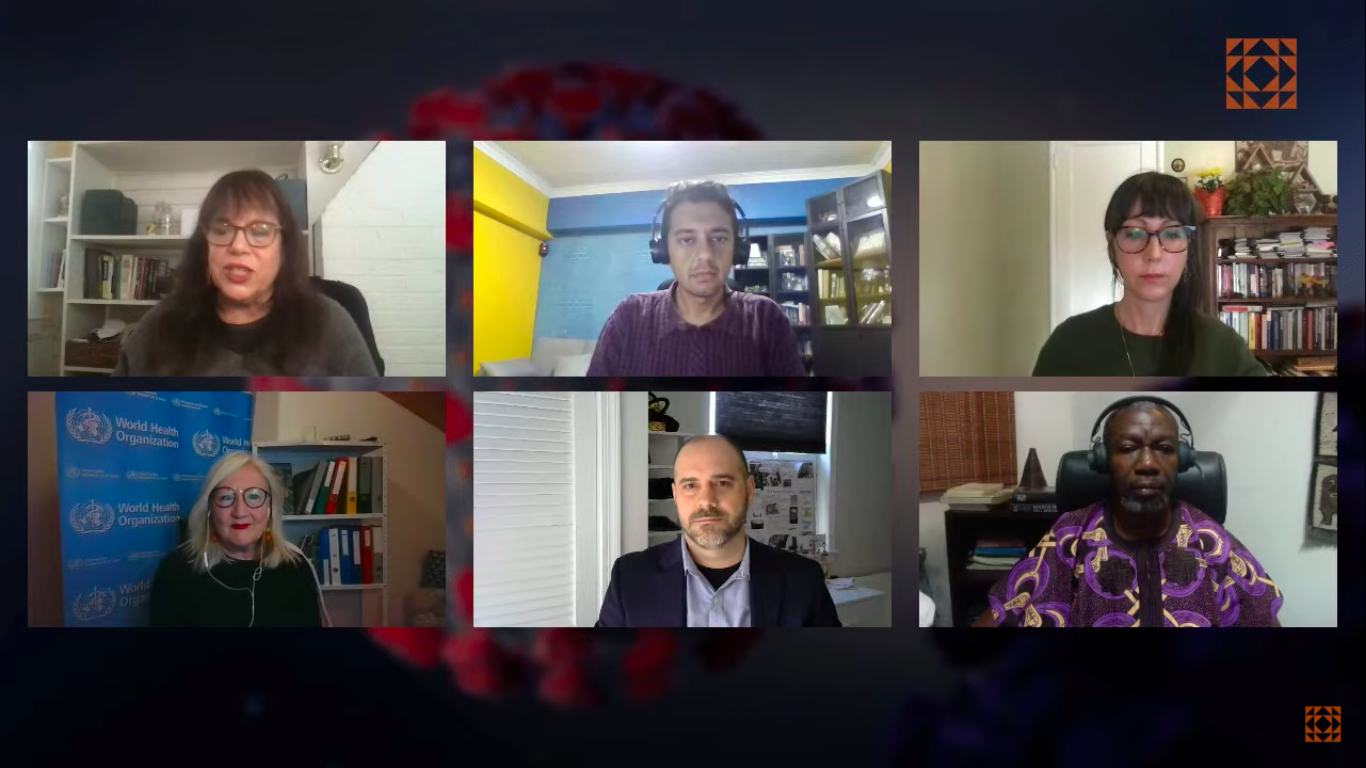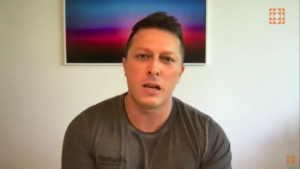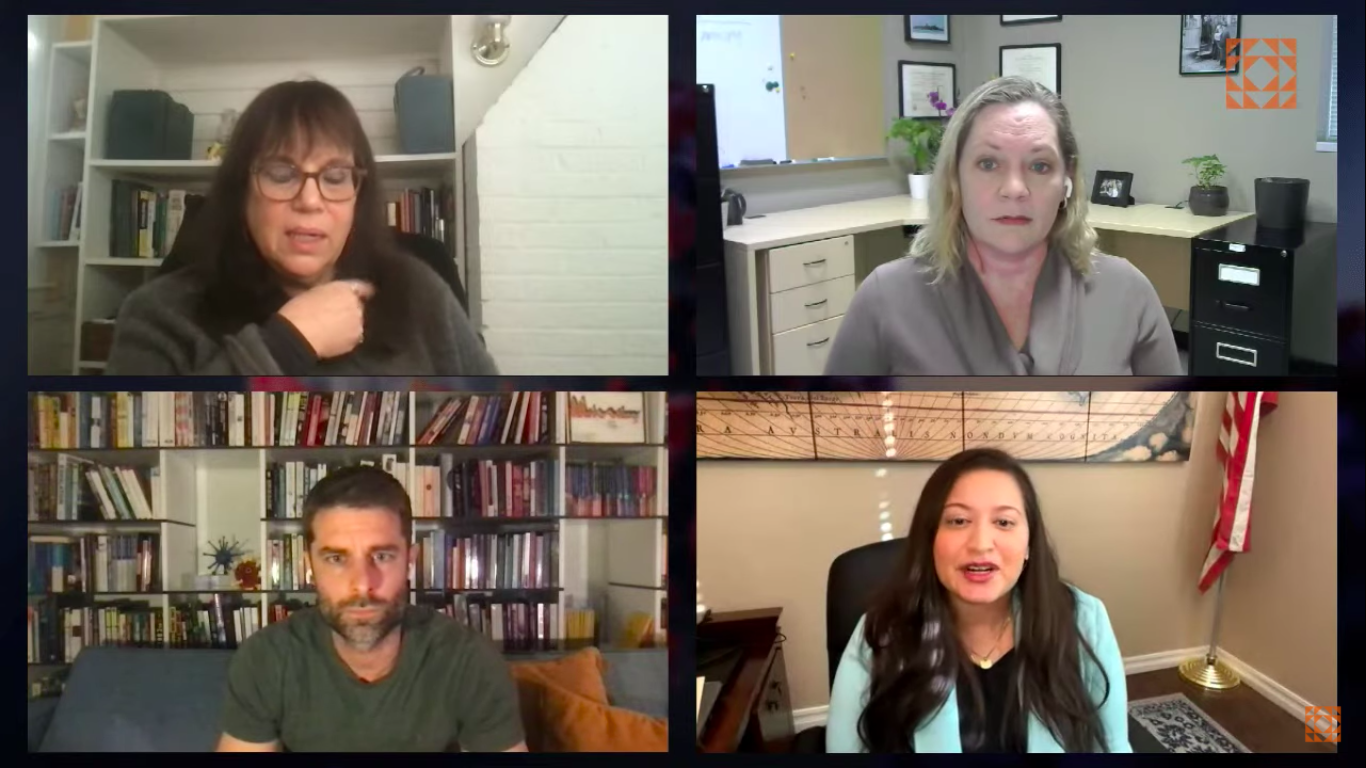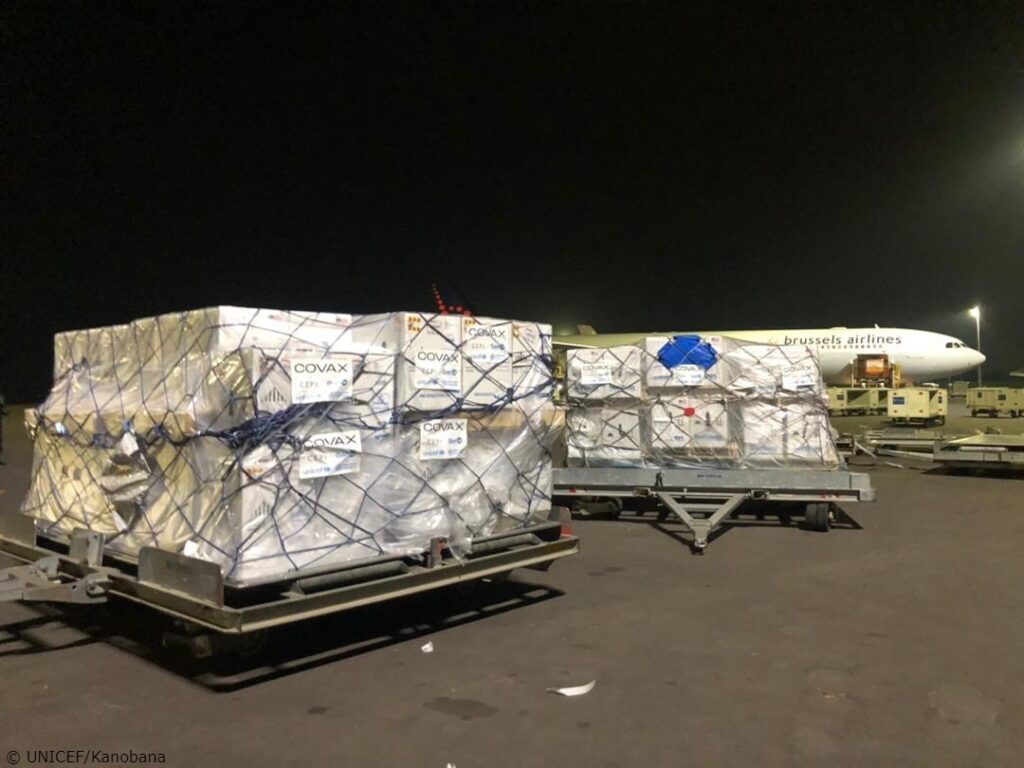With attendees from 85 countries, a leading group of science journalists, scientists, and other experts shared tips and advice on how to better cover the COVID-19 pandemic and combat misinformation surrounding vaccines, variants and treatments.
The webinar "Variants, vaccines and medications: What journalists need to know to improve COVID-19 coverage," was organized by the Knight Center for Journalism in the Americas and held in partnership with UNESCO, funded by the World Health Organization and UNESCO’s Multi-Donor Programme on Freedom of Expression and Safety of Journalists. It was broadcast live on Thursday, Jan. 27, through Zoom and YouTube.
The Zoom broadcast, originally in English with simultaneous interpretation into four other languages, was viewed by 770 attendees from 85 countries.

The three panels of the webinar were moderated by Deborah Blum, director of the Knight Program in Science Journalism at MIT (upper left). (Photo: Screenshot)
Recordings of the webinar are available on the Knight Center's YouTube channel in English, Spanish, French, Portuguese, and Arabic. All information about the event, including the program and panelists's details, is available in English, Spanish, French, Portuguese, and Arabic on the Knight Center's JournalismCourses.org site.
The three seminar panels were moderated by Deborah Blum, director of the Knight Science Journalism Program at the Massachusetts Institute of Technology (MIT).
In the opening session, Gabby Stern, WHO communications director, posed a series of questions she said she would have liked to have asked herself when she was a reporter and that journalists today should be asking themselves when covering the COVID-19 pandemic:
1. Is this story worth pursuing and publishing ASAP or am I rushing to get something out because I feel pressured to produce copy and get bylines and/or because another news outlet had it and I/my editors want to match it?
2. Am I on a quest to find a specific type of conflict or failure — and produce a piece that will feel like a mini expose — rather than entering into the reporting process with eyes and intellect wide open to what I might find or might not find?
3. Is this situation real and important, or am I buying into the framing of a source or sources who are acting in bad faith and who may be using me to embarrass or harm the people I’m covering?
4. Do I have a true understanding of the power dynamics and incentive structures which are at work here–in terms of my role and relationship with my sources as well as the people I’m covering.
5. Have I spent enough time and brain power coming to understand the people I am covering beyond their public utterances and other easy to get things?
6. Have I put in the hard work to get behind the scenes, inside the meeting rooms and corridors to understand "who's zooming who," to quote Aretha Franklin?
7. Have I spent the time needed to understand the roles, governance structures, legal authorities, leverage and/or constraints empowering or limiting the people and institutions I’m covering?
“These are questions that not enough reporters ask themselves when writing about the pandemic and politics, the result of which are stories that are buzzy and cool but are basically cheap and cheerful scooplets that send other reporters down unimportant and even harmful rabbit holes when they could be making genuinely valuable contributions to a world in distress,” Stern said.
Fear, mistrust and misinformation
The first panel, “Disinformation & Evolving Data,” featured Davey Alba, a reporter for The New York Times specializing in internet disinformation, from the United States; Mandi Smallhorne, President of the South African Science Journalists Association and Vice President of the World Federation of Science Journalists; Jane Qiu, a freelance science journalist for media such as Nature, The Lancet and National Geographic, from China; and Federico Kukso, author and independent science journalist, board member of the World Federation of Science Journalists, from Argentina.
Speakers discussed the real damage that misinformation and the spread of fake news have caused, including costing lives during the COVID-19 pandemic.
Misinformation around vaccines, for example, has fueled the fears of thousands of people who have chosen not to get vaccinated. That is an issue that journalists must treat carefully to avoid contributing to the growth of those fears, Alba said. She added that the misleading content about COVID-19 that has flooded social networks since 2020 has had a high impact on decisions that users make.
"We know that these things go viral, we know that they find an audience, they reach enormous amounts of people. We also know, on sort of a more anecdotal track, when you see people coming into hospitals with COVID and refusing to get vaccines that the thing that they talk about are the lies that they see online," Alba said. "There’s really powerful anecdotal evidence that people are starting to believe in part some of these things that they hear online and that is a factor in vaccination. That is something that every misinformation expert I have spoken to says."
In Mandi Smallhorne's opinion, that has a lot to do with the distrust many people have towards the scientific community. In Africa, that mistrust stems in large part from actions that governments and pharmaceutical companies have taken in the past, such as testing polio or HIV vaccines without public knowledge, which has caused people to mistrust Western science.
According to Smallhorne, journalists should focus their coverage on trying to figure out the reasons behind those fears and mistrust, that make readers believe false information they see online.

Newspapers in the region [Latin America] rarely hire science journalists, said Argentine journalist Federico Kukso. (Photo: Screenshot)
In Latin America, the mistrust and fears that facilitate belief in fake news have to do with the fact that science is not an important part of the agendas of governments or the media, according to Kukso.
This adds to the fact that newspapers in the region rarely hire science journalists. Therefore, it is not uncommon for the media to fall into what Kukso called "the hype": exaggerate the information or not give it its fair dimension. This has happened in Latin America with issues such as the use of hydroxychloroquine, vaccines or convalescent plasma treatments.
“Last month, when there started to be many breakthrough infections in Latin America, many people started saying the vaccines were not working, mainly because the news media tend to describe vaccines as shields that cover you from the virus,” Kukso said.
Kukso recommended trying to be more moderate with the information published, being careful with sources and avoiding exaggerations.
“Take into account that behind press releases there are big companies,” he said. “We all want to hear or read news that some drug or treatment will end this pandemic forever, but I think that, in the end, it ends up eroding people's confidence in science.”
The confusion surrounding variants
One of the topics that has generated the most misinformation during the pandemic is that of the SARS CoV-2 variants. The second panel of the webinar, "Mutations & Variants," featured scientists Purvi Parikh, allergist and immunologist at the Allergy and Asthma Associates Institute of Murray Hill, in the United States; and Angela Rasmussen, a virologist at The Vaccine and Infectious Disease Organization at the University of Saskatchewan, in Canada; as well as science journalist for Science Magazine in Germany, Kai Kupferschmidt.
The goal of the panel was to help attendees deepen their knowledge about the mutations suffered by the COVID-19 virus, the variants that appear and the differences between them.
Panelists agreed that journalists should start from the idea that it is normal for an RNA virus like SARS CoV-2 to mutate into different variants and that it is not surprising that new forms of this virus will continue to appear in the future.
The exact origins of both the virus and its variants are still unknown, so the media must take special care in the words they choose to explain this topic to avoid contributing to disinformation.
An example of misleading information in this regard is the argument that the equitable distribution of vaccines is a way to stop the appearance of new variants. Although it has been proven that equitably applying vaccines would reduce the fatality rate of the virus, it has been seen that new variants have also emerged in countries with high vaccination rates, Kupferschmidt said.
"As long as we don’t know how these variants evolve, I feel like we are overstepping if we say we know how to avoid them evolving. This is just one of those examples where we tell the stories and we don’t understand why we tell them," Kupferschmidt said. "Sometimes you use this argument to argue for equitable access to vaccines and [...] it doesn’t mean that it’s true. I think, in the long run, in all of these debates we lose a lot of credibility."

Speakers on the second panel discussed the mutations that the COVID-19 virus undergoes, its variants, and the differences between them. (Photo: Screenshot)
Another frequent example of terms conveying the wrong message is saying that the Omicron variant is less dangerous than the previous ones. While vaccinated people have been shown to be less likely to end up in hospitals after being infected with Omicron, saying that this variant causes a "milder" disease is not an absolute truth, Parikh said.
“Even the word 'mild' sometimes makes me cringe because it’s the wrong word. It conveys the wrong message to the general public that [Omicron] is not to be taken as seriously," Parikh said.
Kupferschmidt said that the way vaccines are discussed, their distribution and their characteristics affect the narrative around the topic. And that resistance to immunization can have various reasons and is therefore an issue that should be approached very carefully.
As an example, he mentioned that the way in which the side effects of the AstraZeneca vaccine were discussed in some European countries led to the creation of a narrative that a low-quality product was being donated to lower-income countries, when that vaccine has been shown to be effective.
For Kupferschmidt, journalists must make an effort to bring quality information about vaccines to the public to combat the polarization that has been generated in this regard.
"We must work to counter this polarization because I really worry that even for other vaccines, but especially the coronavirus vaccine, polarization is going to make it pretty much impossible to use these vaccines in the best way possible and to get people to look at them in a rational way," Kupferschmidt said.
Medications and vaccines
In the third and final panel, "Vaccines & medications," a group of editors and experts offered a global context on new medical developments to combat SARS CoV-2. Speakers included Margaret Harris, spokesperson on COVID-19 for WHO; Akin Jimoh, editor of Nature Africa, in Nigeria; Amy Maxmen, senior reporter for Nature, in the United States; Josh Michaud, deputy director of global health at the Kaiser Family Foundation, in the United States; and Mohammed Yahia, executive editor of Nature Research in the Middle East, from Egypt.
The latter spoke of the consequences of poor communication around COVID-19 vaccines in Egypt, both from the media and from authorities. He said that even some members of the medical community expressed their doubts about vaccines and their side effects on social networks, which has contributed to the creation of an anti-vaccine discourse.
"That created a kind of fear among the population, so when the availability [of vaccines] became better, a lot of people were very resistant to getting these vaccines," Yahia said. "Historically, there’s never been an antivax movement per se in Egypt, people take childhood vaccines very seriously. Everyone gets them, everyone believes in how effective they are. Everyone is very concerned to make sure that they get these vaccines. But when it came to that particular vaccine, it was just different. People did not want to get it because of all the communication surrounding it."
Journalists need to know how to choose the right sources of information on COVID-19 and hold politicians and health authorities accountable for the type of information they disseminate, said Jimoh. He added that in Nigeria, what politicians who were uninformed about the virus said about COVID-19 caused irreparable damage in terms of disinformation.
"When you look at COVID, we have to look at who understands COVID, because when you hold government accountable, you also need to hold he scientific community accountable," Jimoh said. "In a number of countries, politicians were the first to speak out about COVID, we know about the [case of the] former president of the United States."

Speech by politicians who are uninformed about COVID-19 has caused a lot of damage in Nigeria in terms of disinformation, Nature Africa editor Akin Jimoh said.
Jimoh said that the media in his country did a good job of covering the emergence of HIV in the 1990s, despite the fact that it was also an unknown virus and there was a lot of false information about supposed cures, even from scientific institutions and the government.
"The media came against those establishments in the way we addressed the issues, holding scientific community, the ministry of health responsible, accountable for the kind of information that we had," Jimoh said. "When HIV came, we didn’t have social media at that time. We had to go to what we had as journalists, getting to journals to write the story."
But despite all the misleading and confusing information that exists on the subject, journalists must be aware that there is a problem of distribution of vaccines and logistics to apply them, and they must also hold the authorities accountable for it.
"I feel like all of the issues that everybody has talked about, with misinformation and also how the media would blow up anything for clicks sometimes, it seems like, which it has been pretty disastrous, supply is still an issue, to be clear," Maxmen said. "For example, in Nigeria where there’s 2% of people who are fully vaccinated, that’s not because there’s enough vaccines for everyone to get two doses and a booster and just nobody wants them. There’s a lack of logistics in place, but there’s also a huge lack of supplies."
For Maxmen, the media should question governments about why more vaccines are not being manufactured for developing countries.
Michaud added that, while in 2021 stories were mainly focused on the lack of vaccines, in 2022 the narrative could be different. Although it is expected that there will be more and new vaccines, the demand will also grow due to the appearance of new variants.
"The challenge is more complex, because now we have to pay attention more to the distribution side, and the challenges that the other panelists have raised on that, we have to combat hesitancy and misinformation," Michaud said.
Harris highlighted the work that the WHO has done in distributing not only vaccines, but also other supplies to combat COVID-19, such as tests, protective equipment and oxygen. She also mentioned that UNICEF's strong vaccine distribution system has contributed to a better operation, in terms of logistics, of the COVAX (COVID-19 Vaccines Global Access) system, the global alliance to support the development, manufacturing and distribution of vaccines against COVID-19 launched in April 2020 by the WHO, the European Commission and France.
"We are much happier with where we are getting, but its not like we can sit back. Now that the supply is coming in, we have to also ensure that countries are getting a good advance warning and are ready to use every vaccine they get," Harris said.

The WHO COVID-19 spokesperson said UNICEF's robust vaccine distribution system has contributed to an improved COVAX vaccine delivery system. (Photo: UNICEF Facebook)